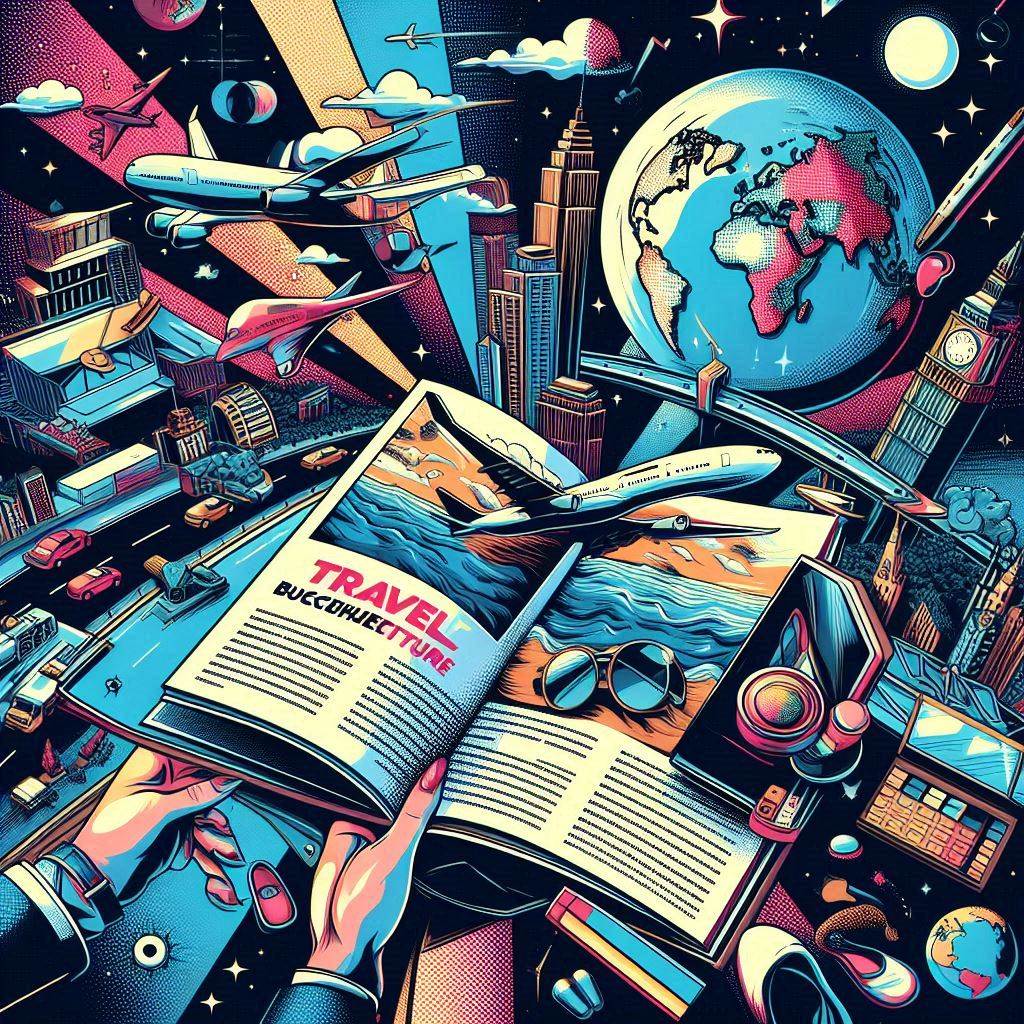- Why You Need a Travel Brochure
- How to Create Your Travel Brochure
- How to Share Your Travel Brochure Online using Tiiny host
- Additional Steps to Make Your Travel Brochure Better
- FAQ: Creating a Travel Brochure: Best Practices and Examples
A well-designed travel brochure is more than just a collection of images and text; it’s a powerful marketing tool that can inspire wanderlust, inform potential travelers, and drive bookings. Whether you’re promoting a single destination, a tour package, or your entire travel agency, a travel brochure is essential in conveying the excitement and beauty of the travel experience.
Why You Need a Travel Brochure
Travel brochures remain one of the most effective marketing tools in the travel industry, even in the digital age. Here’s why:
- Visual Appeal: Travel is an inherently visual experience. A brochure, with its vibrant images and colorful layouts, can capture the essence of a destination in a way that text alone cannot.
- Tangible Marketing: Physical brochures provide a tangible marketing tool that potential customers can take home, browse at their leisure, and share with others. They serve as a constant reminder of the destination or service.
- Credibility and Professionalism: A well-crafted brochure adds credibility to your business. It shows that you’ve invested in quality marketing materials, which can increase customer trust.
- Convenient Information Source: Brochures compile all necessary information in one place, making it easier for travelers to make decisions without having to search multiple sources.
- Targeted Marketing: Brochures can be tailored to specific audiences, whether it’s luxury travelers, adventure seekers, or families. They allow for focused messaging that resonates with your target market.
How to Create Your Travel Brochure
1. Define Your Objective
Purpose
Determine what you want to achieve with your brochure. Are you promoting a specific destination, offering a tour package, or showcasing multiple travel options?
Target Audience
Identify who you are creating the brochure for. Are they adventure seekers, luxury travelers, families, or business travelers? Tailoring your content to your audience will make the brochure more effective.
See for example, Matt Kepnes has created a travel guide with specific audience who wish to travel and explore Paris.
2. Research Your Destination
Gather Information
Research the key attractions, activities, and amenities of the destination. Include information about cultural landmarks, local cuisine, and unique experiences.
Current Trends
Stay updated with current travel trends, such as eco-tourism, digital nomadism, or wellness retreats, and incorporate relevant elements into your brochure.
This travel brochure from Lonely Planet for Italy showcases the top spots that one could visit.
3. Choose the Right Format
Print or Digital
Decide whether your brochure will be printed or distributed digitally. Printed brochures are great for travel agencies and trade shows, while digital brochures can reach a wider online audience.
Layout Style
Choose a layout that suits your content. Common formats include bi-fold, tri-fold, and Z-fold brochures. Each offers different space for text and images, so select one that fits your needs.
4. Create an Eye-Catching Cover
Use high-quality images that capture the essence of the destination. The cover should be visually appealing and instantly grab attention. Write a catchy title and a short, enticing tagline that gives a glimpse of what the brochure offers. Make sure it resonates with your target audience.
Outlook Travel Magazine has simple yet eye-captivating images with clear texts that would attract audience to look through the brochure.
5. Design the Brochure Layout
Consistent Branding
Use colors, fonts, and design elements consistent with your brand. This helps create a professional look and strengthens brand identity.
Organize Content
Structure the brochure logically. Begin with an introduction, followed by detailed information about the destination or services, and conclude with a call to action.
Balance Text and Images
Ensure a balance between text and images. Too much text can overwhelm readers, while too many images may leave them without enough information.
6. Write Engaging Content
Use vivid language to describe the destination. Highlight key attractions, activities, and unique experiences that travelers can look forward to. Try to add essential details such as accommodation options, transportation, weather, and best times to visit. This helps travelers make informed decisions.
Encourage readers to take the next step, whether it’s booking a trip, visiting a website, or contacting a travel agent. Include contact information and social media links.
The travel guide by Lonely Planet includes various colors and imagery but also apt descriptions and additional tips that would be helpful for the travelers.
7. Use High-Quality Images
Choose stunning images that showcase the beauty and uniqueness of the destination. Professional photos or high-resolution images are ideal. Include a mix of landscape views, close-ups of cultural landmarks, and images of activities or local life. This variety keeps the brochure visually engaging.
The I love NY travel guide has shots for all parts of the mentioned place along with pictures from various activities so that a traveler would know which area they might want to visit.
8. Review and Proofread
Ensure all information is accurate and up-to-date. Double-check facts, figures, and contact details. Review the brochure for spelling and grammatical errors. A polished brochure reflects professionalism and attention to detail.
9. Print or Distribute Digitally
Printing
Choose a high-quality printer and paper to give your brochure a professional finish. Consider the brochure’s durability, especially if it’s for frequent handling.
Digital Distribution
If digital, optimize the brochure for online viewing. Use a PDF format for easy sharing and make it accessible via your website, email campaigns, or social media.
10. Monitor and Update
Monitor the effectiveness of your brochure by tracking how many bookings or inquiries it generates. Use tools like Google Analytics for digital brochures. Travel trends and destination details can change, so periodically review and update your brochure to keep it relevant and accurate.
How to Share Your Travel Brochure Online using Tiiny host
The easiest way to share your travel brochure is through Tiiny.host, which lets you publish and distribute easily with a few simple steps.
- Navigate to the Tiiny.host’s homepage
- Upload your PDF file
- Give your link a name or leave it blank
- Create an account or sign in, then hit publish
If you want a quick video guide on turning your brochure into a shareable website, you can follow this video tutorial.
If you need any help while distributing your travel brochure, you can contact our support executives.
Additional Steps to Make Your Travel Brochure Better
Optimize for Different Platforms
If your brochure is digital, ensure it’s optimized for mobile devices. Many travelers will browse it on their phones or tablets, so a responsive design is crucial. Consider creating shareable snippets or teasers from your brochure for use on social media platforms. This can help drive traffic to the full brochure.
Utilize Storytelling
Weave a narrative throughout the brochure that takes the reader on a journey. Rather than just listing attractions, tell a story about the destination that evokes emotions and paints a vivid picture of the experience.
Provide Testimonials and Reviews
Include testimonials from past travelers or ratings from trusted review sites. Social proof can significantly influence decision-making and lend credibility to your offerings.
Consider Multilingual Options
If you’re targeting international travelers, consider producing multilingual versions of your brochure. This makes it accessible to a broader audience and shows respect for different cultures.
Include QR Codes or Links for Easy Access
Integrate QR codes or short URLs that lead to more detailed information, videos, or booking platforms. This bridges the gap between the physical and digital worlds, providing a seamless user experience.
You can also embed your travel brochure as a QR code on your websites or any other companies you partner with.
FAQ: Creating a Travel Brochure: Best Practices and Examples
What software can I use to create a travel brochure?
You can use a variety of software tools to create a travel brochure, depending on your design skills and needs. For beginners, tools like Canva and Adobe Spark offer user-friendly templates. For more advanced users, Adobe InDesign, Illustrator, or even Microsoft Publisher provide greater design flexibility. Online platforms like Lucidpress and Flipsnack are also great for creating digital brochures.
How can I make my travel brochure environmentally friendly?
To create an eco-friendly travel brochure, consider using recycled paper and eco-friendly inks if you’re printing it. For digital brochures, optimize the file size to reduce energy consumption during distribution and access. Additionally, you can promote sustainability within the brochure itself by highlighting eco-tourism options and encouraging responsible travel practices.
Should I include pricing in my travel brochure?
Including pricing in your travel brochure can be beneficial if you want to provide transparency and help potential customers make informed decisions. However, if your prices frequently change, consider directing readers to your website for the most current pricing. This approach ensures that the brochure remains relevant for longer periods.
What are some cost-effective ways to produce a travel brochure?
Cost-effective ways to produce a travel brochure include using free or low-cost design tools like Canva or Google Slides. For printing, opt for bulk printing to reduce costs, or choose digital-only distribution (distributing your PDF using Tiiny host is FREE!) to eliminate printing expenses altogether. You can also save money by using free stock images or photos you’ve taken yourself.



